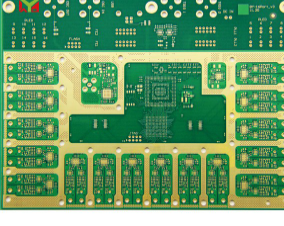Immersion Gold (ENIG)
ENIG's protection mechanism: A thick layer of nickel-gold alloy with good electrical properties is wrapped on the copper surface and can protect the PCB for a long time. Unlike OSP, which is only used as an anti-rust barrier layer, it can be useful in the long-term use of PCB and achieve good electrical performance. In addition, it also has tolerance to the environment that other surface treatment processes do not have;
Ni/Au is plated on the copper surface by chemical method. The deposition thickness of the inner layer of Ni is generally 120 to 240 μin (about 3 to 6 μm), and the deposition thickness of the outer layer of Au is relatively thin, generally 2 to 4 μinch (0.05 to 0.1 μm). Ni forms a barrier layer between solder and copper. During soldering, the Au on the outside will quickly melt into the solder, and the solder and Ni will form a Ni/Sn intermetallic compound. The gold plating on the outside is to prevent Ni oxidation or passivation during storage, so the gold plating layer should be dense enough and the thickness should not be too thin.

Immersion gold: In this process, the purpose is to deposit a thin and continuous gold protective layer. The thickness of the main gold should not be too thick, otherwise the solder joints will become very brittle, which will seriously affect the reliability of welding. Like nickel plating, immersion gold has a high working temperature and a long time. During the dipping process, a displacement reaction will occur-on the surface of nickel, gold replaces nickel, but when the displacement reaches a certain level, the displacement reaction will automatically stop. Gold has high strength, abrasion resistance, high temperature resistance, and is not easy to oxidize, so it can prevent nickel from oxidation or passivation, and is suitable for working in high-strength applications.
The PCB surface treated by ENIG is very flat and has good coplanarity, which is the only one used for the contact surface of the button. Secondly, ENIG has excellent solderability, gold will quickly melt into the molten solder, thereby exposing fresh Ni.
Limitations of ENIG:
ENIG's process is more complicated, and if you want to achieve good results, you must strictly control the process parameters. The most troublesome thing is that the ENIG-treated PCB surface is prone to black pads during ENIG or soldering, which will have a catastrophic impact on the reliability of solder joints. The generation mechanism of the black disk is very complicated. It occurs at the interface of Ni and gold, which is directly manifested as excessive oxidation of Ni. Too much gold will make the solder joints brittle and affect reliability.
4. Chemical Immersion Silver
Between OSP and electroless nickel/immersion gold, the process is simpler and faster. When exposed to heat, humidity and pollution, it can still provide good electrical performance and maintain good solderability, but it will lose its luster. Because there is no nickel under the silver layer, immersion silver does not have the good physical strength of electroless nickel/immersion gold;
5. Electroplating nickel gold
The conductor on the PCB surface is electroplated with a layer of nickel and then electroplated with a layer of gold. The main purpose of nickel plating is to prevent the diffusion between gold and copper. There are two types of electroplated nickel gold: soft gold plating (pure gold, gold indicates that it does not look bright) and hard gold plating (the surface is smooth and hard, wear-resistant, contains cobalt and other elements, and the surface looks brighter). Soft gold is mainly used for gold wire during chip packaging; hard gold is mainly used for electrical interconnection in non-soldering places (such as gold fingers).
6. PCB hybrid surface treatment technology
Choose two or more surface treatment methods for surface treatment, the common forms are: Immersion Nickel Gold + Anti-oxidation, Electroplating Nickel Gold + Immersion Nickel Gold, Electroplating Nickel Gold + Hot Air Leveling, Immersion Nickel Gold + Hot Air Leveling .
Among all surface treatment methods, hot air leveling (lead-free/leaded) is the most common and cheapest treatment method, but please pay attention to the EU's RoHS regulations.
RoHS: RoHS is a mandatory standard established by EU legislation. Its full name is "Restriction of Hazardous Substances" (Restriction of Hazardous Substances). The standard has been formally implemented on July 1, 2006, and is mainly used to standardize the material and process standards of electronic and electrical PCB products to make it more conducive to human health and environmental protection. The purpose of this standard is to eliminate six substances including lead, mercury, cadmium, hexavalent chromium, polybrominated biphenyls and polybrominated diphenyl ethers in electrical and electronic products, and it specifically stipulates that the lead content cannot exceed 0.1%.